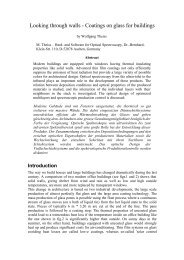CODE Tutorial 1 - W. Theiss Hard- and Software
CODE Tutorial 1 - W. Theiss Hard- and Software
CODE Tutorial 1 - W. Theiss Hard- and Software
Create successful ePaper yourself
Turn your PDF publications into a flip-book with our unique Google optimized e-Paper software.
<strong>CODE</strong> <strong>Tutorial</strong> 1 Example 1: Low-E coatings<br />
You may notice that you can reduce the emission from 408 to 61 W/cm^2 with a silver<br />
thickness of 2.5 nm only. The spectra in the visible are hardly influenced by this thin metal film.<br />
However, it is not possible up to now to produce large scale Ag films with that thickness<br />
because Ag starts to grow as an inhomogeneous isl<strong>and</strong> film on glass. These isl<strong>and</strong> films are very<br />
colorful <strong>and</strong> do not help to reduce infrared emission very much (see SCOUT tutorial 2). You<br />
must have a thickness of 7 to 8 nm to produce a homogeneous film with the wanted properties.<br />
These thicker films reduce the transmission of the window significantly <strong>and</strong> are also not neutral in<br />
color.<br />
To directly visualize the color, open the list of integral quantities <strong>and</strong> create an object of type<br />
'Color view'. As with the spectrum product object, assign the simulated transmission spectrum to<br />
the 'Colorview' object:<br />
Drag the new integral quantity from the treeview to the list of view items <strong>and</strong> drop it there. This<br />
will generate a view object that can display the color view object in the main view. Move the<br />
new view element to the bottom of the center rectangle <strong>and</strong> size it the following way:<br />
16<br />
© 2012 Wolfgang <strong>Theiss</strong>



